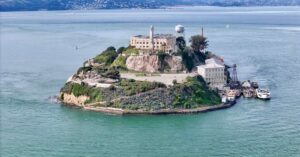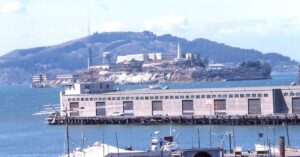Alcatraz Federal Penitentiary, perched on a rocky island in the middle of San Francisco Bay, has long symbolized maximum-security incarceration. Known as “The Rock,” it was designed to house the most dangerous criminals in America—those deemed too unpredictable or violent for other prisons. Yet, despite its reputation as inescapable, the prison has been at the center of one of the most mysterious escape stories in U.S. history.
Though several inmates attempted to flee Alcatraz, none captured the public imagination more than the daring escape of 1962. Decades later, the question still remains: Did they survive?
Table of Contents
ToggleThe Design and Security of Alcatraz
Alcatraz operated as a federal prison from 1934 to 1963. Its isolated location—over a mile from the San Francisco shoreline—and the treacherous, icy waters surrounding it made escape virtually impossible. The prison’s infrastructure was built with escape prevention in mind. Cell doors were reinforced with tool-resistant steel, and the building itself was constantly monitored by guards stationed in elevated towers and along perimeters.
In total, 36 inmates made 14 separate escape attempts during the prison’s operational years. Of these, 23 were captured, six were shot and killed, two drowned, and five disappeared without a trace. These five continue to spark speculation, particularly the three who executed the most famous and mysterious escape: Frank Morris and brothers John and Clarence Anglin.
The 1962 Escape: Ingenious and Unforgettable
On the night of June 11, 1962, Morris and the Anglin brothers vanished from their cells. Their plan, reportedly developed over six months, involved painstaking efforts and remarkable ingenuity.
Using stolen tools—including a metal spoon sharpened into a chisel and an improvised drill made from a vacuum cleaner motor—they widened the air vents at the back of their cells. The walls, built with crumbling concrete due to years of moisture exposure, gave way slowly. They covered the holes with cardboard and painted them to match the walls, hiding their progress from guards.
Behind the cells was an unguarded utility corridor. Each night, they crawled through these holes into the corridor, stashing supplies and working on a makeshift raft constructed from over 50 stolen raincoats, which they glued together using heat from steam pipes.
To fool the guards during nightly checks, they crafted dummy heads from papier-mâché, soap, and real hair taken from the prison barbershop. On that June night, after placing the heads in their beds, the men slipped through the vent holes, climbed a ventilation shaft, and made their way to the roof. From there, they descended to the water and launched their raft.
By morning, they were gone. The prison went into full lockdown, and a massive manhunt ensued.
The Investigation and the Official Theory
The FBI launched an investigation that lasted for 17 years. In the days following the escape, authorities recovered remnants of the raft and a paddle on nearby Angel Island. They also found a plastic-wrapped wallet containing family photos and addresses, believed to belong to the Anglins.
Still, no bodies were ever found, and no concrete proof of survival surfaced. The FBI concluded the men had likely drowned in the frigid, fast-moving currents. The bay’s water temperature averages 53°F (12°C)—cold enough to cause hypothermia within minutes. Moreover, none of the men had any confirmed experience with open-water swimming.
In 1979, the FBI formally closed the case. However, the U.S. Marshals Service kept it open and active, and as of today, it remains an open fugitive case.
Theories and Alleged Sightings
While the official record leans toward death by drowning, alternative theories have emerged over the decades, many backed by suggestive—if not conclusive—evidence.
1. The Brazil Photo
In 2015, a photograph surfaced that allegedly shows the Anglin brothers in Brazil, taken in 1975. The image, handed over by a family friend, shows two men resembling the Anglins standing near a farmhouse. A forensic expert who analyzed the photo claimed it showed a strong resemblance to the escaped brothers.
Though intriguing, the photo has never been officially authenticated. Still, it supports what the Anglin family has long believed: that John and Clarence survived and fled to South America.
2. The 2013 Letter
Another twist came in 2013 when a San Francisco TV station received a letter, allegedly written by John Anglin, claiming that all three men survived the escape. According to the letter, Morris died in 2008, Clarence in 2011, and John was seeking medical care in exchange for surrendering. The letter stated: “This is no joke.”
The FBI tested the letter for fingerprints and DNA but found inconclusive results. The agency eventually dismissed it as a hoax, but others found the details credible enough to consider it seriously.
3. Ocean Current Simulations
In 2014, a team of Dutch researchers created computer simulations based on historical tide and weather data from that night. Their findings were surprising: If the men had launched their raft between 11 p.m. and midnight, the current could have actually carried them safely across the bay to the Marin Headlands.
These findings didn’t prove the escape was successful but showed it was possible—a significant shift from previous assumptions.
The Cultural Legacy of the Escape
The role of pop culture is part of what has kept the escape story alive. Escape from Alcatraz, a 1979 film based on the story and starring Clint Eastwood as Frank Morris had the events dramatised and introduced the story to a broader audience. Many documentaries, books, and podcasts have analyzed that escape ever since, keeping the interest of the population.
Today, people who visit the Alcatraz Island tend to spend the better part of their time exploring the escape route, looking into the cells where the men used to be, and frequently asking rangers: Were they actually able to get out?
Conclusion: Did They Survive?
The 1962 Alcatraz escape is one of the most intriguing unsolved cases of criminology in American history. Though the FBI upholds that the men drowned, other evidence including testimonies of relatives and scientific models, point to the contrary.
Did Morris and the Anglin brothers die in the cold waters or live peacefully in exile? Other questions remain to be answered, but the story still captures the imagination of many. It questions the boundaries of what we think is achievable and it also highlights the human desire to pursue freedom even when the odds are against us.
Over 60 years after, the question remains to be answered: Did they beat The Rock? The Alcatraz escape will continue to be an interesting myth as well as a mystery until conclusive evidence is discovered.


